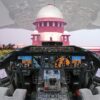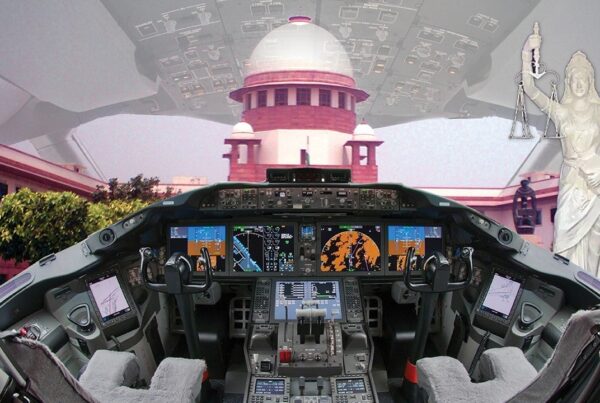
In our last article, Hiding in Plane Sight, we outlined the sequence of events that led to the AI 171 plane crash. We made the claim that the fuel cutoff switches were a red herring, and current media narratives of pilot error or pilot action cannot be explained by the data provided in the Preliminary Report VT-ANB that was released by the Aircraft Accident Investigation Bureau of India (AAIB) on July 12.
In that article, we had highlighted three images from the Preliminary Report, and labeled them as Exhibit A, Exhibit B, and Exhibit C. In this article, we will focus on those three images and the data provided in the Preliminary Report, and state with certainty what happened in the seconds after AI 171 took off from Ahmedabad Airport and the root cause for the crash.
We show for a fact that it wasn’t pilot error or deliberate pilot action and that the pilots acted professionally and as trained. Whether current media narratives are deliberate misdirection, gross incompetence, or a result of a colonial hangover, that is for the reader to determine. Before we get into that and to follow our argument through, first we must familiarize ourselves with two basic lessons in high-school physics.
Lesson 1 – Acceleration, Velocity, Distance, Time
The distance travelled by an object can be calculated using the object’s initial velocity, the final velocity, and the time duration. Given initial velocity v0, final velocity v1, the time duration t, and assuming constant acceleration, we can calculate the distance travelled.
distance = v0 * t + ½(v1 – v0) * t
We want to get an estimate for the horizontal distance travelled by AI 171 after it took off to the time that the fuel valve was closed. The below data is from the Preliminary Report.
08:08:39 UTC Liftoff, Liftoff speed was 162 Kts
08:08:42 UTC Engine 1 Fuel valve cutoff. Reached max speed of 180 Kts
v0 = 162 Kts = 83.34 meters/second
v1 = 180 Kts = 92.6 meters/second
t = 3 seconds
Distance travelled in 3 seconds = 83.34 * 3 + ½ * (92.6 – 83.34) * 3 = 264 meters
In 3 seconds, the aircraft travelled a horizontal distance of 264 meters after takeoff. The aircraft had taken almost the full length of the runway to takeoff. 264 meters beyond the takeoff point is well beyond the edge of the runway. In the first second after takeoff, the aircraft travelled around 88 meters.
The CCTV image (Exhibit A) clearly shows that the RAT had deployed. In the image, the RAT has come out of the fuselage where it is stowed and is in the extended position. It shows that the RAT had definitely deployed some hundreds of milliseconds before this image was taken. The AAIB report did not timestamp the image. Even if there had been a timestamp, we cannot rely on it as clocks drift and we have to sequence all events based on the flight data recorder’s reference clock.
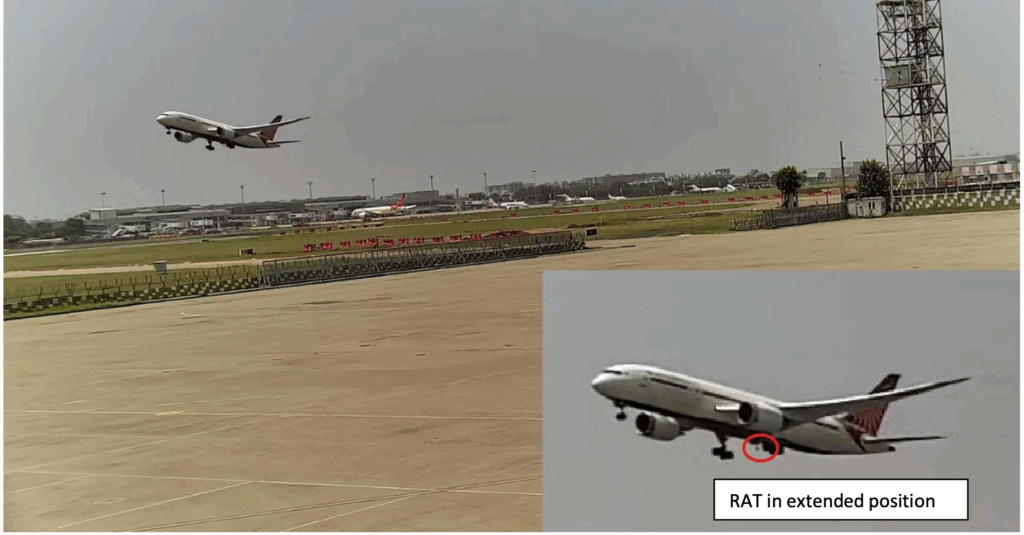
Exhibit A (RAT had deployed prior to aircraft crossing airport boundary wall)
Exhibit A image shows AI 171 at the edge of the runway with the Ahmedabad Airport Domestic Terminal at the back. We can triangulate the camera location and angle with FlightRadar24, Google Earth, Google Maps, and flight speed data to get the exact time, based on the flight data recorder’s reference clock, at which the photo was taken. The figure below clearly shows that the CCTV camera image was taken between 08:08:39 UTC and 08:08:40 UTC. The RAT takes about 800 milliseconds to fully extend out of the fuselage. What we can say for a certainty is that the event that caused the deployment of the RAT happened closer to the 08:08:39 UTC than 08:08:40 UTC. Engine 1 fuel valve was closed at 08:08:42 UTC, almost three seconds after the event that caused the RAT to deploy.
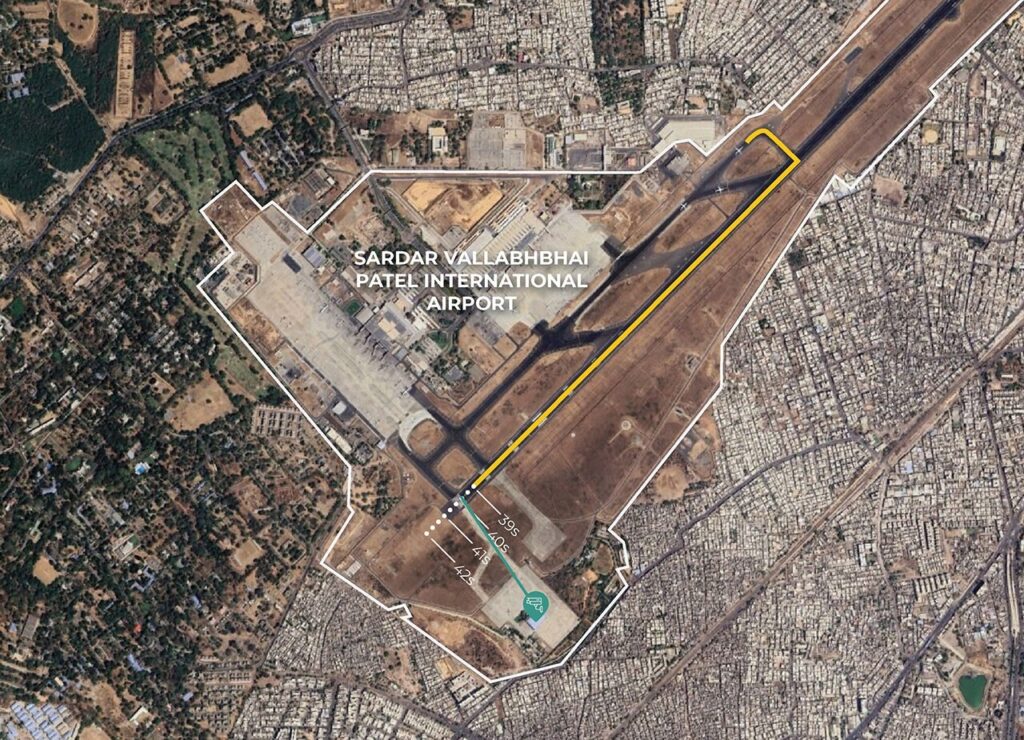
Triangulating camera location and angle with FlightRadar24, Google Earth, Google Maps and Flight speed data
Current media narratives explain the RAT deployment as the result of the fuel switches in the cockpit being moved to CUTOFF. The fuel switch off of Engine 1 happened at 08:08:42 UTC, 3 seconds after liftoff when the aircraft was 264 meters from the takeoff point. Shutting off the fuel switch did not cause the RAT to deploy. The figure above shows for a fact that the RAT had deployed before the fuel switch off was done.
We are now ready to make our first assertion.
Assertion 1 – Ram Air Turbine (RAT) deployed between 08:08:39 UTC and 08:08:40 UTC. Engine 1 fuel valve was closed at 08:08:42 UTC. We can definitively say that the closing of the Engine 1 fuel valve was not the cause for the RAT deploying.
If the RAT deployed before the fuel was cutoff, what caused the RAT to deploy? To answer that, we have to refresh ourselves with our second lesson in high-school physics.
Lesson 2 – Melting and Boiling Points of Metals
The Boeing 787 Dreamliner is equipped with two Enhanced Airborne Flight Recorders (EAFRs). The EAFRs (black boxes) are fitted at two locations, one in the tail section and other in the forward section. These black boxes are carefully engineered to withstand the force of a high speed impact and the heat of an intense fire. The exterior of the black box is coated with a heat-resistant bright orange paint for high visibility in wreckage. The black box is rated to withstand 3400 g-force and 1000° C.
The Dreamliner’s black boxes are double wrapped in strong corrosion resistant stainless steel and titanium, with high-temperature rated insulation inside. The table below shows the melting point and boiling points for steel and titanium. The melting point of a metal is the point at which it transitions from a solid to a liquid. The boiling point of a metal is the temperature at which it transitions from a liquid to a gas.

Melting and Boiling points for steel and titanium
Black boxes are made of steel and titanium as these metals can withstand and insulate the electronics and memory cards inside from extreme temperatures. A jet fuel fire burns at temperatures much below 1000° C topping out at about 800° C. Double shielding and insulating the black box with titanium and steel with melting points well over 1500° C, ensures that the data is protected and can be retrieved in the event of a disaster.
The below are the images of black boxes recovered from the Lion Air 610 Boeing 737 MAX crash and the Ethiopian Airlines Flight 302 Boeing 737 MAX crash.
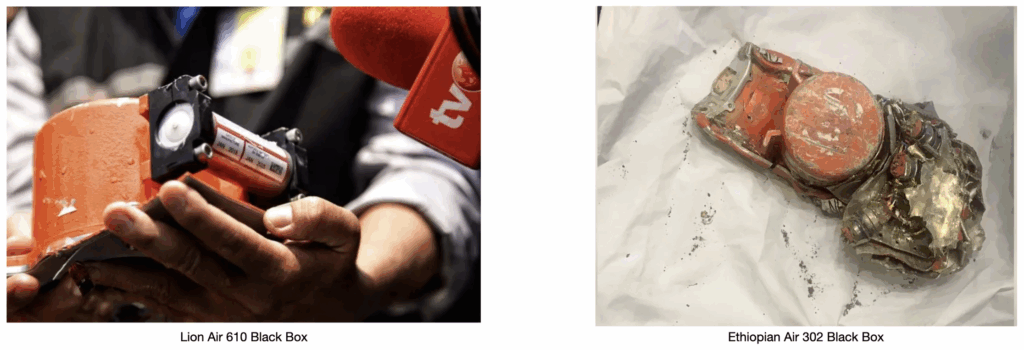
Lion Air Photo Credit: Pradita UTAMA/AFP/Getty Images, Ethiopian Air Photo Credit: Ethiopian Investigation Team/Twitter/BEA_Aero
In both cases, there is no visible external damage to the black boxes. It has not just survived, even the heat resistant orange paint has not been much damaged. The figure below shows the images of the AI 171 black boxes (Figure 14, Page 12 of Preliminary Report VT-ANB).

Aft EAFR (Exhibit C) on left and Fwd EAFR (Exhibit B) on right
The rear black box (Exhibit C) was found first and data could not be read from it. The forward black box (Exhibit B) was found after a few days, its orange paint burnt away from the heat of the jet fuel fire. The FDR and the VCR were found undamaged and data was retrieved. The impact and heat rating of the forward black box stood its test.
The rationale for the placement of the EAFR in the tail section is that the tail section is statistically less likely to sustain severe damage during a crash, increasing the likelihood of recovering intact data. The tail section was found embedded into a building with no visible external fire damage.
What caused this extent of damage to the rear black box? There is no external fire damage to the tail, but the aft EAFR clearly went through an intense thermal event; an intense fire so hot that it not just melted the steel and titanium shielding but vaporized it, melted the ULB (Underwater Locator Beacon), compromised the CPM (Crash-Protected Memory), and caused extensive thermal damage to the memory cards.
The Preliminary Report VT-ANB, has this line (Page 13),
The aft EAFR was substantially damaged and could not be downloaded through conventional means. The CPM was opened to inspect the memory card. The damage was extensive.
High school physics tells us that steel and titanium vaporize at temperatures of 2750° C and 3290° C respectively. The image of the tail section in the Preliminary Report shows no evidence of external jet fuel fire on the tail section. Gasoline fires cannot generate these high temperatures and the forward black box shows clearly that it could withstand a jet fuel fire.
The only thing that can generate this intense heat is a thermal runaway event of a Lithium-ion battery. Located near the Dreamliner’s aft EAFR in the aft avionics bay is the APU’s (Auxiliary Power Unit) Lithium-ion battery. The sole survivor made a statement that he heard a loud bang and lights flickered in the cabin during takeoff. The electric wiring of the Dreamliner 787 is shown below.
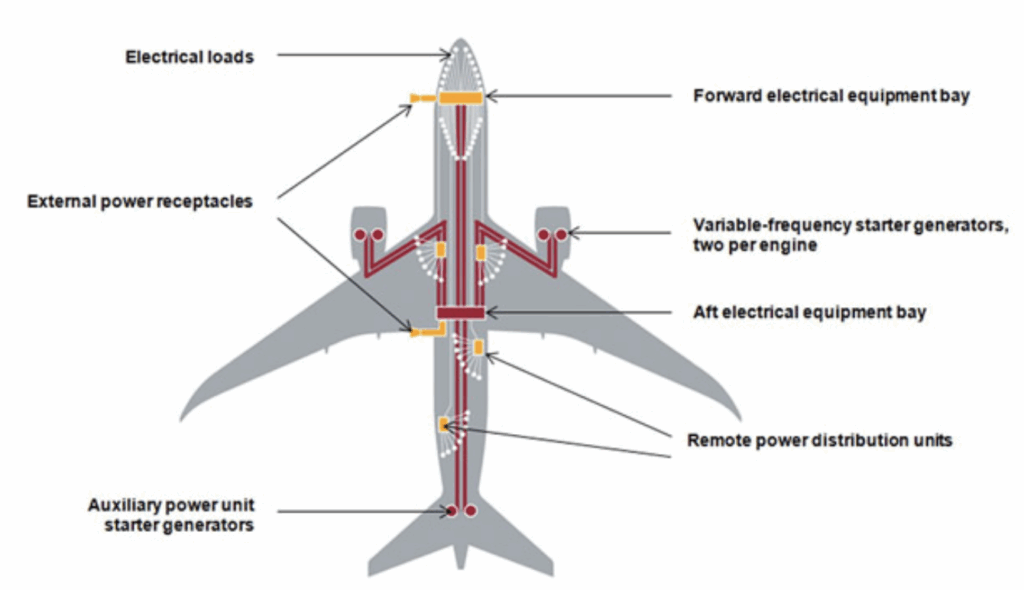
Boeing 787 Electrical System, Image Credit: Boeing
All the data and images in the Preliminary Report points to a catastrophic failure in Generator 2 of the Auxiliary Power Unit (APU) immediately after takeoff (read our article Hiding in Plane Sight on how the failed restart of Engine 2 reinforces the argument of a compromised APU Generator 2). It is only a thermal runaway event of the Lithium-ion battery of APU 2 that can explain the damage to the aft EAFR.
We are now ready to make our second assertion.
Assertion 2 – Between 08:08:39 UTC (AI 171 liftoff) and 08:08:40 UTC (RAT deployed), there was an intense thermal event in the tail section of the plane that raised the temperatures to well above 3000° C (temperatures high enough to vaporize steel and titanium).
The Usual Suspects
In October 2018, Lion Air Flight 610, a Boeing 737 MAX 8 aircraft, crashed into the Java Sea thirteen minutes after takeoff. The flight’s cockpit crew included Captain Bhavye Suneja (31), an Indian national, and First Officer Harvino (41), an Indonesian. The crash was investigated and blamed on pilot error. Neither the Indonesian government nor the Indian government stood up for their pilots.
On 10 March 2019, Ethiopian Airlines Flight 302, a Boeing 737 MAX 8 aircraft, crashed six minutes after takeoff. In command was Captain Yared Getachew (29) and First Officer Ahmednur Mohammed (25). On 11 March 2019, the US Federal Aviation Authority (FAA) commented that the Boeing 737 MAX 8 model was airworthy. Boeing CEO Dennis Mullenburg made public assurances that the airplane was safe. In contrast, the Ethiopian Civil Aviation Authority (ECAA), responsible for investigating civil aviation accidents in Ethiopia, stood up for their pilots.
One week after the crash, ECAA investigations revealed that the preliminary black box flight data showed a clear similarity with that of Lion Air Flight 610. ECAA’s final report stated –
Repetitive and uncommanded airplane-nose-down inputs from the MCAS due to erroneous AOA input, and its unrecoverable activation system which made the airplane dive with the rate of -33,000 ft/min [−170 m/s] close to the ground was the most probable cause of the accident.
The key word to internalize is the word ‘uncommanded’. The plane was acting without pilot input or awareness. It was algorithmic decision-making that brought down the planes.
AAIB should take a lesson from ECAA. They stood up for their pilots. Within a week of the crash, they had recovered the data (even though the black boxes had to be sent to France) and convincingly shown for a fact that the root cause for the Flight 302 crash and Lion Air Flight 610 were the same.
Regaining flyer trust requires transparency and truths. Transparency and getting to the truths require competence. Obfuscation is the first line of defense of the incompetent and the guilty.
While western media influencers have been running a clown-show, quoting authoritative unidentified sources and amplifying unverifiable gossip, Indian media has not been far behind. They have put up a circus. As everyone knows, when a circus is in town, it is only a matter of time that the clowns show up. Aviation experts on social media who are deflecting, misdirecting, and talking about depression and mental health issues, are best advised to brush up on their high-school physics.
Action Replay
We now have all the data to reconstruct the sequence of events after AI 171 took off from Ahmedabad airport on June 12, 2025. The figure below shows the temporal sequence of events in the final 32 seconds of Air India Flight 171.

Final 32 seconds of Air India 171 from 08:08:39 UTC to 08:09:11 UTC
Our earlier article, Hiding in Plane Sight, provides more details on FADEC (Full Authority Digital Engine Controls). FADEC is a fully digital control system that replaces manual pilot inputs with algorithmic decision-making. In our last article, we had put a disclaimer. We are data experts. We understand data. This is what the data in the Preliminary Report VT-ANB is telling us. This time, no disclaimers.
You can spin narratives, quote unidentified authoritative sources, hide facts, but you cannot deny science. Data never lies. Data talks if you are willing to listen.
A lesson that the media must understand is that a story may have two sides, but truth only one. The sequence of events that we have described fits every data provided in the preliminary report, connects every pixel in the images, and validates all survivor and observer statements.
Q.E.D.
AAIB has all the physical evidence. It would be very easy to test the aft EAFR and determine if it was destroyed by a thermal runaway fire caused by the APU’s Li-ion battery. On the last page of the Preliminary Report (page 15), it says,
At this stage of investigation, there are no recommended actions to B787-8 and/or GE GEnx-1B engine operators and manufacturers.
If AAIB tests confirm a thermal runaway event, then it might be best to revisit that line.
AAIB must ensure justice to Captain Sabharwal (56) and First Officer Clive Kunder (32). They were the best of the best.
Under the International Civil Aviation Organization (ICAO) rules, the sole objective of the investigation of an Accident/Incident is the prevention of accidents and incidents and not to apportion blame or liability. This is an opportunity for AAIB to step up and create an accident report that is transparent, backed by scientific evidence gathering, using measured words, and suggesting best practices that will restore confidence in the process, help regain trust in the aviation industry, and lead towards making the flying experience seamless, sustainable, and safe for all.
If a thermal runaway incident is proven as the root cause, then AAIB must demand that,
- Aircraft manufacturers disclose all events where FADEC can take control without pilot input and lead to ‘uncommanded’ actions.
- Flight Data Recorders add a field that indicates whether an event was initiated from the cockpit or by FADEC. If this data were available, the knee-jerk reaction would not be pilot-shaming.
- Lithium-ion batteries are known to cause thermal runaway events, generating intense heat exceeding 5000°C. Given this, isn’t the placement of the aft black box, rated for only 1000°C, directly adjacent to the battery a significant concern?
Q.E.D., Hawkai Data rests. Over and out.
This is our analysis using the data and images from the Preliminary Report VT-ANB. The physical evidence is with AAIB, who can easily test, confirm, publish, and put rumors to rest. No comments will be responded to. If you have anything of value to say, say it to the AAIB. Over to AAIB.
References
The AAIB Preliminary Report on AI 171 is available at https://aaib.gov.in/
System Design: Fixing the 787’s Batteries. Walter Shawlee II. Avionics International. June 1, 2013. Available at https://www.aviationtoday.com/2013/06/01/system-design-fixing-the-787s-batteries/
Our earlier article that provides more details on FADEC, uncommanded actions, and the root cause for the crash is available at Hiding in Plane Sight.


